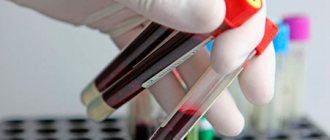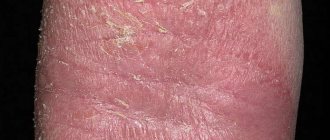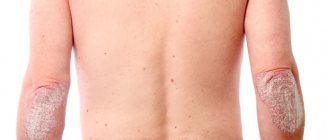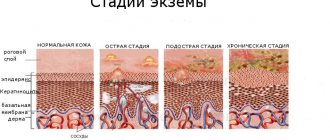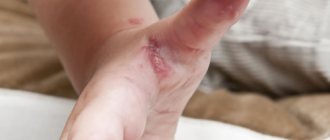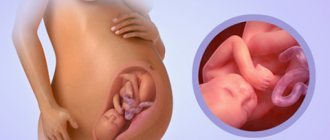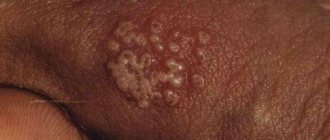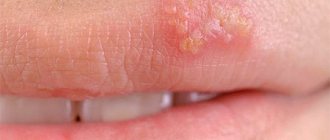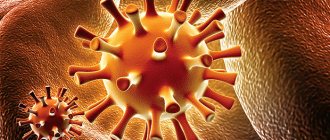Herpes is a chronic viral infection, the carrier of which is almost every person on the planet. Typically, the virus manifests itself by the appearance of bubbles with a clear liquid on the body, which leave behind small ulcers. Their location, symptoms of the disease and method of infection depend on the type of virus.
Treatment for herpes in children is simple; the main thing is for parents to notice the disease in time and contact a specialist.
Causes of herpes infection in a child
In 84% of cases, herpes in a child occurs after contact with infected adults or children in a children's group. Infection also occurs when the disease relapses in the parents. Very often, a one-year-old child is already diagnosed with a cold on the lips, or herpes simplex type 1. This is due to the inability to stop contact between the mother and the newborn during the period of exacerbation of her illness.
Transmission routes
The source of infection can be any adult whose infection is active. The herpes virus is transmitted in several ways:
- Bytovym. Infection occurs when sanitary and hygienic rules are not followed. Family members sharing the same dishes and hygiene items increases the risk of children becoming infected with herpes.
- Airborne. When you talk or sneeze, the virus spreads through the air. It easily penetrates the body through breathing.
- Perinatal. When the disease worsens in the mother during intrauterine development of the fetus, the risk of transmitting the infection to the child increases. Infection occurs before or during childbirth, as well as shortly after delivery.
- Hemocontact. Often the herpes virus in newborns occurs during medical procedures. Blood transfusions and other physical therapy procedures increase the likelihood of infection.
Mothers who first become infected during pregnancy have a 50% chance of giving birth to sick children. According to statistics, more than 80% of children under the age of 7 are already carriers of the pathogen.
Who is more susceptible to the virus?
The likelihood of infectious agents entering a child’s body depends on the impact of negative external and internal factors.
Herpes infection in children occurs as a result of a decrease in the body's immune defense, which can be caused by the following reasons:
- hypothermia or overheating;
- inflammation of the ENT organs;
- poor nutrition;
- psycho-emotional stress;
- vitamin and mineral deficiency.
Treatment with antibiotics, hormonal drugs and cytostatics also leads to weakened immunity. This creates conditions for the virus to penetrate and multiply in the child’s body.
Symptoms in children
The symptoms of different types of herpes vary greatly depending on the age of the child. This is due to the development of the immune system. Therefore, when determining the virus, it is worth taking into account the age of the child.
Symptoms in infants, neonatal herpes
Symptoms depend on the period during which the virus became infected. If the fetus is infected at an early or mid-term stage, then at birth it exhibits the following disorders: epilepsy, central infantile paralysis, destruction or partial disruption of the liver, inflammatory processes in the lungs, eye damage.
Infection that occurs during childbirth or within two weeks after it is called neonatal herpes. It is divided into three forms, depending on the symptoms:
- Localized form. It is characterized only by the appearance of watery blisters in the eyes, mouth and genitals.
- Generalized form . Manifested by lethargy, breathing problems, malfunction of the liver and adrenal glands, regurgitation, convulsions, yellowness of the mucous membranes.
- Amazing form. Manifested by high fever, lethargy with transition to agitation, vomiting, and convulsions.
Clinical manifestations in young children
The disease is milder in younger children than in older children. The acute phase of the virus is manifested by a slightly elevated temperature and the appearance of a rash at the site of its entry into the body. However, if the herpes virus appears in the throat, it is accompanied by high fever, difficulty breathing, inflammation of the tonsils and enlarged lymph nodes.
Symptoms in older children
In older children, the active phase of the virus occurs with high fever, headache, rash, acute itching at the site of the rash, fatigue and irritability, joint pain, inflammatory processes on the mucous membranes, problems with the organs of vision.
Characteristic symptoms of diseases and their consequences
Clinical manifestations of the disease depend on the type of herpesvirus infection and the location of the lesions. Scientists have identified more than 200 varieties of herpesvirus, but only 8 of them are found in humans. All types of herpes in children differ in the nature of the course, symptoms and possible consequences.
Colds on the lips - type 1
Herpes simplex virus type 1 (HSV-1) is the most common form of the disease. Like other herpetic infections, it provokes the formation of grouped blisters on the lips or nasal mucosa. Typical manifestations of oral herpes include:
- temperature increase;
- weakness in the body;
- burning sensation in the lips;
- blistering rashes;
- erosions and ulcers.
The first time infection occurs is through contact with infected adults or during fetal development.
Most often, a child receives his first type 1 herpes from his mother and father, who have had similar rashes on their lips at least once in their lives.
Sometimes the first manifestations of the disease occur in infants as early as 7 months. Due to the underdevelopment of the immune system, the infection progresses rapidly. If left untreated, HSV-1 causes damage to the eyes (keratitis) or the lining of the brain (encephalitis).
Genital herpes – type 2
The disease is caused by herpes simplex virus type 2 (HSV-2). Most often, infection occurs perinatally, that is, during childbirth. To understand what herpes looks like in a child, you need to consider its main manifestations:
- blistering rash on the genitals or anus;
- burning and tingling in the affected areas;
- pain radiating to the buttocks and thighs;
- feverish condition.
After diagnosing the disease, the doctor explains why genital herpes is dangerous, how to relieve symptoms and speed up recovery.
Delayed treatment leads to the spread of infection, the occurrence of herpetic sore throat or stomatitis. Such complications in a child under 3 years of age are fraught with serious health consequences, therefore, if they are detected, the patient is hospitalized.
Chickenpox and herpes zoster – type 3
The disease is caused by the Varicella zoster virus. This is one of the most common types of herpes, which, upon initial infection, causes chickenpox. In patients who have recovered from the disease, the pathogen enters a latent state. It remains in the nerve cells of the spinal roots for many years and is activated only under conditions favorable for reproduction.
In children under one year of age, chickenpox is mild, but when Varicella zoster is reactivated, it is not smallpox that occurs, but herpes zoster. The pathogen migrates to the skin along nerve fibers, so exacerbation causes severe pain. The infection primarily affects the trigeminal and intercostal nerves. In this regard, a rash appears in the ribs, lower back, and sometimes on the face.
It is believed that chicken pox is the only viral disease that remains the most common infectious disease in children to this day.
With timely treatment, the blisters remain on the skin for no more than 3 weeks. In children under 5 years of age with weakened immune systems, herpes zoster is severe. When inflammation generalizes, it causes complications - postherpetic neuralgia, encephalitis, motor paralysis.
Infectious mononucleosis – type 4
The pathology is provoked by herpesvirus type 4 (Epstein-Barr virus), which can also cause other dangerous diseases - lymphoma, nasopharyngeal carcinoma. The contagiousness (contagiousness) of infectious mononucleosis is so high that the infection occurs in 48% of children under 4 years of age. But activation of the virus occurs only in 4-5% of cases, with a decrease in immunity.
Mononucleosis is a highly contagious disease. If the child has been in contact with a sick person, then for 2-3 months parents should pay special attention to any ailment of the baby. If there are no obvious symptoms, this means that the body's immune system is strong enough. The disease could have been mild or infection could have been avoided.
Infection is possible both by airborne droplets and perinatal routes. Therefore, the likelihood of detecting an infection in an infant whose mother suffers from the disease is very high. Typical manifestations of mononucleosis in a child include:
- feverish condition;
- increased sweating;
- body aches;
- enlargement of the submandibular lymph nodes;
- redness of the throat;
- swelling of the laryngeal mucosa;
- pinpoint rashes all over the body.
Often the patient develops headaches, pigment spots on the extremities and itching. The disease can provoke severe complications - meningoencephalitis, facial paralysis, hemolytic anemia, pericarditis, etc.
Cytomegaly – type 5
According to statistics, no more than 1.5% of children are born with cytomegalovirus infection, which is caused by type 5 herpes virus. Most often it is transmitted by airborne droplets or transplacentally.
Diagnosing cytomegalovirus in a child is difficult, therefore, if infection is suspected, a blood test for antibodies is taken to detect antibodies to CMV.
Herpes in a newborn is manifested by the following symptoms:
- rashes on the trunk and limbs;
- skin hemorrhage (bloody blisters);
- hemolytic anemia;
- bloody impurities in the stool.
The congenital form of cytomegaly leads to brain damage. Such a child experiences convulsions, tremors and chronic fatigue. When infected after birth, herpes manifests itself as a cold. Delayed treatment is fraught with damage to the liver, gastrointestinal tract and pneumonia.
Symptoms of other types of herpes virus infection
Diseases caused by herpesviruses 6, 7 and 8 are very rare, but without timely treatment they are fraught with serious complications:
- Pseudo-rubella, or sixth disease, is caused by herpesvirus type 6. In an infant, it manifests itself as red spots and ulcers on the body, acute fever, and inflammation of the nasopharynx. Complicated by chronic fatigue syndrome and encephalitis.
- Herpes type 7 is caused by lymphotropic virions that are localized in blood cells. Transmitted by hematogenous and airborne droplets. Herpes in infants is manifested by fever, spotty rashes on the body, convulsions and fever. In severe cases, it provokes hepatitis and meningoencephalitis.
- Herpes type 8 is transmitted by contact, transplacental and hematogenous routes. Herpesvirus causes a systemic cancer disease (Kaposi's sarcoma) in a child, the symptoms of which are purple nodules on the oral mucosa and skin, oval plaques on the limbs and torso, diarrhea, and persistent cough. With a long course, it provokes elephantiasis of the extremities and lymphostasis (stagnation of lymphatic fluid).
When infected, virions remain in the child’s body forever, but most often remain in a latent state.
Neonatal herpes
Infection with a viral infection occurs during childbirth or during intrauterine development, therefore this form of the disease is often called congenital. The severity of clinical manifestations is determined by the period of infection: the earlier the herpes virus enters the body, the more severe its consequences.
It should be remembered that it is impossible to cure herpes at all, you can only alleviate the symptoms, prevent complications and put the causative agent of the disease into “sleep mode” for the rest of your life.
In 40% of newborns, herpes infection occurs in a localized form. The blistering rash occurs mainly on the oral mucosa and skin. Generalized herpes is more common in children who were infected in the early stages.
What types of virus do children get sick with?
Herpes is a virus that causes the formation of watery blisters on the skin. The main feature is that when it enters the human body, it settles in all organs. It is impossible to cure him. Treatment is reduced to bringing it to a latent state in which it does not appear on the skin.
Doctors count 80-100 types and subspecies, but children most often suffer from 6 types of herpes virus:
- Herpes simplex virus or type 1 , which affects only the skin in the mouth and eyes.
- Herpes type 2 affects the skin in the genital area.
- Herpes type 3 or Zoster , covering the entire body.
- Epstein-Bar virus , which causes infectious mononucleosis.
- Cytomegalovirus, which infects tissue in the salivary glands.
- Herpes type 6 or pseudocranuch.
What is needed for diagnosis
A dermatologist or infectious disease specialist makes a diagnosis based on symptoms, laboratory and instrumental studies. To understand what to do next and how to treat herpes, determine the type of pathogen. For this purpose, the following types of examinations are carried out:
- clinical blood test;
- PCR diagnostics;
- smear microscopy of discharge from vesicles;
- Ultrasound examination of internal organs.
When making a diagnosis, herpetic infection is differentiated from rubella, allergic dermatitis, and ARVI. After determining the form of the disease, the pediatrician draws up a suitable treatment regimen for the child.
How to cure herpes in a child
Treatment of herpes infection in children should be comprehensive. To relieve local manifestations, ointments and gels are used, and tablets are used to destroy infection throughout the body. Before treating herpes in a 2-year-old child, you should consult a pediatrician. Many antiviral and immunostimulating drugs are not prescribed to patients under 11-12 years of age due to the risk of adverse reactions.
The classic treatment regimen for herpes includes the following drugs:
- antiviral tablets (Valacyclovir, Famvir, Acyclovir) - inhibit the reproduction of virions and alleviate the course of the disease;
- antiviral ointments and creams (Virolex, Panavir, Zovirax) – eliminate the vesicular rash and prevent its spread to healthy tissue;
- immunostimulants (Cycloferon, Arpetol, Amiksin) – increase the body’s resistance to viral infections;
- antipyretics (Viburkol, Paracetamol) – eliminate the symptoms of fever, eliminate body aches;
- antihistamines (Clemastine, Diazolin, Erius) - relieve swelling, itching, redness and other allergic manifestations.
If the mucous membrane of the eyes is affected, antiviral eye ointments are prescribed - Acyclovir, Oftalmoferon, Bonafton. Also, treatment of herpes in children is accompanied by taking painkillers (Efferalgan, Nimesulide, Naproxen). Combined-action drugs not only relieve pain due to herpes zoster in a child, but also lower body temperature.
To cure herpes at home, you must follow sanitary and hygienic rules. Frequently changing bedding and underwear reduces the risk of the rash spreading throughout the body. Foci of inflammation are treated with local preparations at least 3-5 times a day.
Immunity to herpes
The human immune system is not able to completely destroy the causative agent of a viral disease. Virions are localized in nerve endings, so granulocytes, T-lymphocytes and other protective cells do not have access to them. Activation of HSV occurs only if conditions favorable for this are created in the body. When immunity decreases, the virus penetrates skin cells and begins to actively multiply.
Currently, trials of a vaccine against herpes types 1, 2 and 3 are still underway. But it does not protect against infection, but only reduces the number and duration of relapses.
To prevent herpes on the skin in children, it is necessary to monitor the immune status of the body. To increase the defenses, pediatricians recommend giving the child vitamin and mineral complexes:
- Vitrum Baby;
- Supradin Kids;
- Pikovit;
- Alphabet;
- Complivit.
Before using medications, it is advisable to consult a doctor who can accurately determine the dosage and duration of vitamin therapy.
Why is it dangerous?
The virus itself is harmless and when treated, apart from unpleasant sensations in the form of itching and rash, it does not cause any problems. However, due to the similarity of symptoms with other diseases, it often develops into a severe form, which already gives the following complications:
- serious damage to the organs of vision that leads to blindness;
- disorders of the liver and adrenal glands;
- serious disorders of the nervous system (cerebral palsy, herpetic encephalitis, epilepsy);
- the formation of blood clots in small vessels - disseminated intravascular coagulation syndrome;
- the appearance of acute stomatitis and gingivitis.
However, neonatal herpes is considered the most dangerous, especially its generalized and damaging form. In these cases, the mortality rate of newborn children reaches 90%. Therefore, it is important to timely determine the presence of the virus in infants.
Prevention
HSV is transmitted in different ways, so it is very difficult to prevent primary infection of a child during pregnancy and childbirth or contact with adults. But maintaining personal hygiene and strengthening the immune system reduce the risk of activation of pathogenic agents. To avoid relapse of the disease, you should:
- eat well;
- avoid stress;
- treat ARVI in time;
- exercise;
- take multivitamins;
- wash your hands after a walk;
- treat skin lesions with antiseptics.
According to statistics, more than 90% of children under the age of 11 are carriers of HSV. This is due to insufficient immune defense and non-compliance with sanitary and hygienic rules. By following the pediatrician's recommendations, you can reduce the risk of infection and reactivation of herpes in a child several times.

